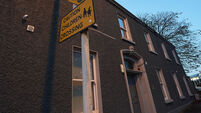Photo Essay: Unsung heroes work behind the scenes at Haulbowline's Naval Dockyard
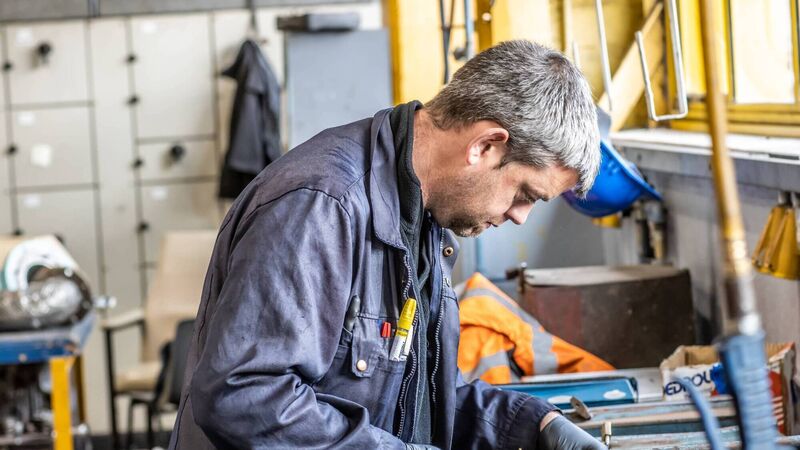
Mechanical fitter and father-of-two, Liam Leahy, at the Naval Dockyard in Cork. “I’m part of a great community here in the dockyard". Photo: Neil Michael
"We were now faced with looking at people drowning in front of us."
Petty Officer David O’Leary was part of the LÉ Samuel Beckett boarding parties in the Mediterranean Sea in 2016.
The expert electronics engineer uttered those words about five minutes into the acclaimed and brutally emotive December 2016 RTÉ documentary, The Crossing.
This was also shortly before he jumped into the sea to save a woman and child floating face down in front of him.
He was describing rescuing migrants crossing the Mediterranean from Libya to Europe as part of the Irish Naval Service’s migrant rescue operation between 2015 and 2016.
In the 18 months before the documentary aired, the crews of five Naval Service vessels deployed to the Mediterranean had rescued 14,000 people.
Although the Naval Service no longer supplies ships to help in the Mediterranean, that tally of saved lives was a massive achievement.
But while the crew of the LÉ Samuel Beckett featured in The Crossing got the plaudits they deserved, there was a small army of mostly unsung heroes back home.
They were the men and women who work behind the scenes making sure Ireland’s Naval Services fleet sails out of Cork Harbour, let alone reaches the Mediterranean.
Indeed, if it wasn’t for the 180 or so staff working at Cork’s Naval Dockyard at Haulbowline Island, none of the ships would be able to operate.
They include around 60 civilians in a variety of jobs in engineering, marine mechanics, welding, plumbing and admin staff. With a few notable exceptions like Petty Officer O’Leary, you rarely hear about them.
If they are not in uniform, they mostly wear drab blue denim overalls, have dirty, chip-nailed hands, and sometimes the biggest compliment anyone ever gives them is a hearty chortle to one of their jokes.
And where they work is very far from the horrific 2016 drama of the Mediterranean.
Instead, their working environment is - in effect - a cramped 17th-century parking lot for a handful of ships, surrounded by drab grey huts and workshops.
Much of the dockyard structure dates back to the 1700s, when - in 1720 - the world’s first yacht club was established there.
The dockyard itself was built by the British in the 1860s as a place to maintain its warships.
And instead of the screams of people crying out for help in the Mediterranean, the sounds that dominate the dockyard are the guttural grunts of cormorants fishing nearby, and the wind clinking halyards from the yachts moored in the now-defunct 408ft-deep former dry dock adjoining the dockyard.
There are also the shrill sounds of unseen drills and saws, hammer bangs, the whining drive of a crane, and occasional echo against the stone slabs that line the dockyard of dockside banter and laughter.
Or there is the sound of seamen barking orders from a deck over the bow down below to Naval Service seamen standing unsteadily on a raft moored alongside as they paint the hull.
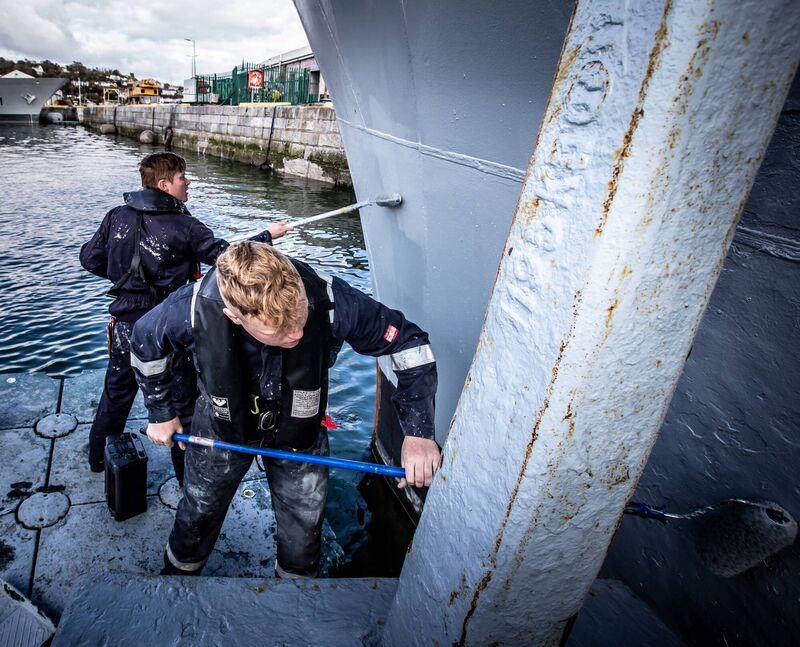
There might also be the heavy thuds of footsteps marching up a gangway to a ship from the dockside as sailors carry broad square wooden crates of fresh bread in front of them to a ship preparing to set sail.
Responsible for heavy technical support for the Naval Services ships and a small fleet of Rigid-Hulled Inflatable Boats (RHIBs), the Mechanical Engineering and Naval Dockyard (MENDY) Unit is one of four main departments in the Naval Support Command on the island.
It operates alongside the Weapons Electrical Unit, one of the other departments.
Between them, they service the fleet of nine ships, four of which are - in effect - out of action.
The flagship, the LÉ Eithne is on operational reserve and moored alongside the West Wall of the dockyard, a wall that has no servicing facilities or proper access and is, staff point out, “just a wall”.
Although it is not on active duty, its generators are on constantly to keep its engines - which have to be restarted once-a-week - warm.
The LÉ Orla is also on operational reserve and moored alongside the LÉ Róisín which is berthed at the North Wall while she undergoes a major refurbishment.
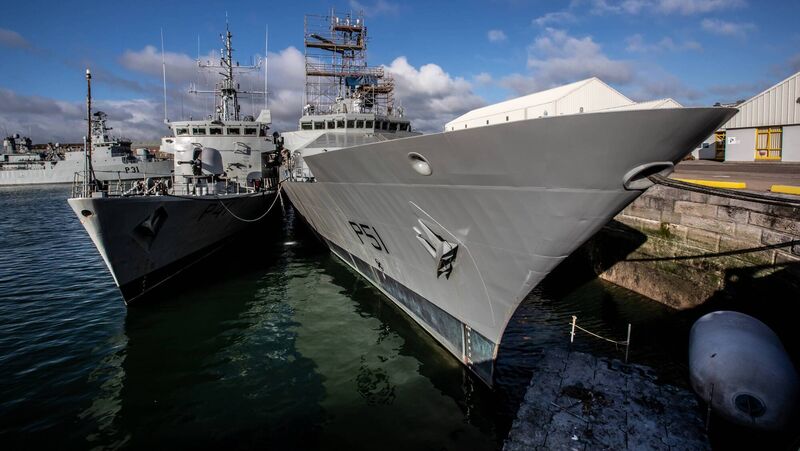
The LÉ Niamh is still being repaired after a fire broke out on it while she was undergoing planned maintenance at Cork Dockyard, Rushbrooke.
So, with the South Wall not suitable for mooring any ships, and with the dry dock being out of action, this just leaves the East Wall available for berthing alongside.
It’s also the only wall suitable for crane operations at the moment, a point that irritates navy chiefs running a 17th-Century facility for a 21st-Century navy.
When the Irish Examiner visited in October, the LÉ Samuel Beckett - one of the five active ships - was moored up on the East Wall, undergoing routine maintenance before going on operational patrol around the Irish coast.
While all Naval Services staff are trained to do basic maintenance, it's the dockyard staff who do the complicated stuff.
Staff at the Weapons Electrical Unit, which includes Petty Officer O’Leary, and the Naval Ordinance Section (NOS) maintain and repair all things electrical such as radar, radios, and internal communications systems on ships.
They also repair and refurbish the 76mm Oto Melara cannons mounted at the front of the ships, as well as their Rheinmetall 20mm Rh-202 1030 rounds-per-minute cannons.
The staff at the Mechanical Engineering and Naval Dockyard Unit (MENDY) look after just about everything else.
And that includes anything from spare parts for the ships, engine maintenance, and servicing, fuel, and other supplies.
They also maintain the Naval Service’s small fleet of Rigid-Hulled Inflatable Boats (RHIBs), as part of the Fleet Support Group.
These play a vital role in all of the Naval Service’s missions.
Liam Leahy is typical of a lot of the 60 or so civilian workers at the dockyard.
The 38-year-old father of two has worked with ships since he was 17, starting out at the Cork Dockyard across the way from Haulbowline.
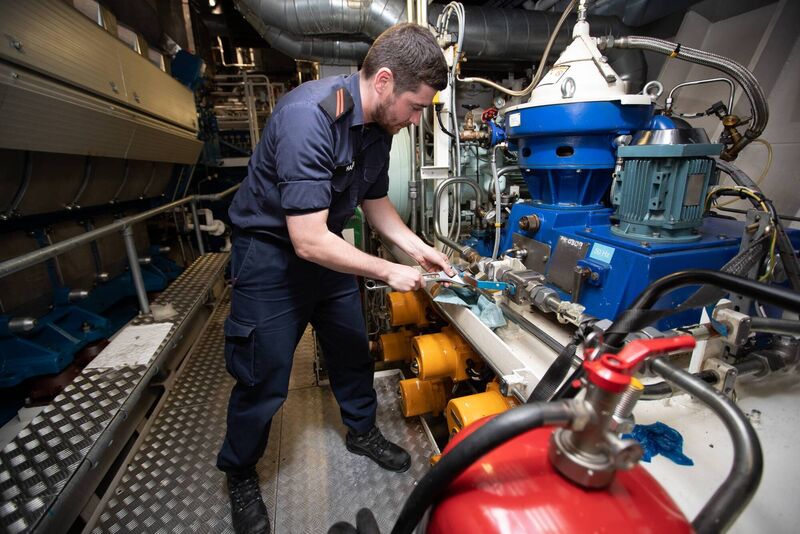
He has had two brothers in the Naval Service, and his 76-year-old father Seamus was in the Merchant Navy before working as a marine fitter in Cork Dockyard.
“Apart from the fact that I love my job, it’s very convenient that I live nearby in Cobh and get to work every morning in the Naval Services cross-harbour launch.
“I’m part of a great community here in the dockyard and in Cobh and I often ask myself, where would you get it?
“As a mechanical fitter here, I do a very broad range of work and have picked up skills I would not have got in any other job.”
Does he ever lie awake in bed at night worrying the work he did somehow came unstuck? Without hesitation, he replies: “No.”
He says:
"We sleep easy in our beds at night knowing we’ve done our jobs properly so the others can do their jobs in places like the Atlantic or the Mediterranean.
“We don’t really get the credit for what we do, but then we all have a tremendous sense of pride in the work we do.” It’s impossible to talk about the dockyard without mentioning issues it faces.
These are part of what Defence Minister Simon Coveney recently described in the Dáil as the “particular problem” that is the Naval Service.
Like other sections of the Defence Forces, the dockyard has problems retaining staff - many of whom are approaching retirement age.
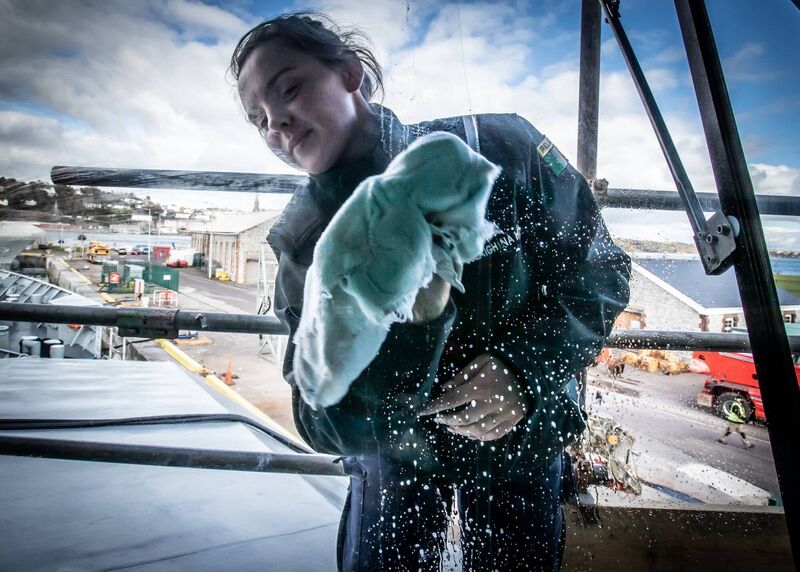
Apart from the retention issue, there is also the issue of attracting new staff.
“Today’s generation doesn't want to be away from phone reception,” the Naval Dockyard’s Officer in Charge, Lieutenant Commander David Lyons says when asked about recruitment issues.
President Michael D Higgins’ former military Aide De Camp also believes part of the problem the Naval Service faces is the public perception of it.
He describes this as the country’s collective “sea blindness”.
He says:
"And many of those who do realize we have one, don’t really understand what we actually do.” Naval Dockyard Officer Commanding Cian O'Mearain adds: “Tying up ships affects recruitment, and losing the Mediterranean didn't help.
“Once that ended, there hasn’t been much in the way of adventure.” He goes quiet when he watches scenes from The Crossing, which is loaded onto his laptop.
He plays the opening 10 minutes and suddenly everyone in his office and nearby stops talking. It's a very noticeable change.
As this reporter later leaves the dockyard, two men spring gingerly down a gangplank from the LÉ Róisín.
Both are wearing hard hats and carrying toolboxes, they saunter past with a cheery wave to a small group of men at the entrance to a workshop.
LÉ George Bernard Shaw (#P64) on patrol last weekend conducting #Maritime #Defence & #Security Operations (MDSO) @defenceforces 🇮🇪. #WinterIsComing pic.twitter.com/YOmRwSbLzc
— Irish Naval Service (@naval_service) December 14, 2020
Their work is done for the day. Someone makes a joke at the expense of one of the two men. Everyone - including him - laughs. It’s Petty Officer O’Leary.
Few who saw The Crossing will ever forget the raw emotion crackling through in his voice as he shouted to colleagues to bring their RHIB round to the limp body of a child lying face down in the water.
This was seconds before he dived into the sea to save her life.
Behind the cheeky Cork banter and dockyard laughter, you don’t have far to go to bump into a hero.










